Disaggregated HDP Spark and Hive with MinIO
1. Cloud-native Architecture
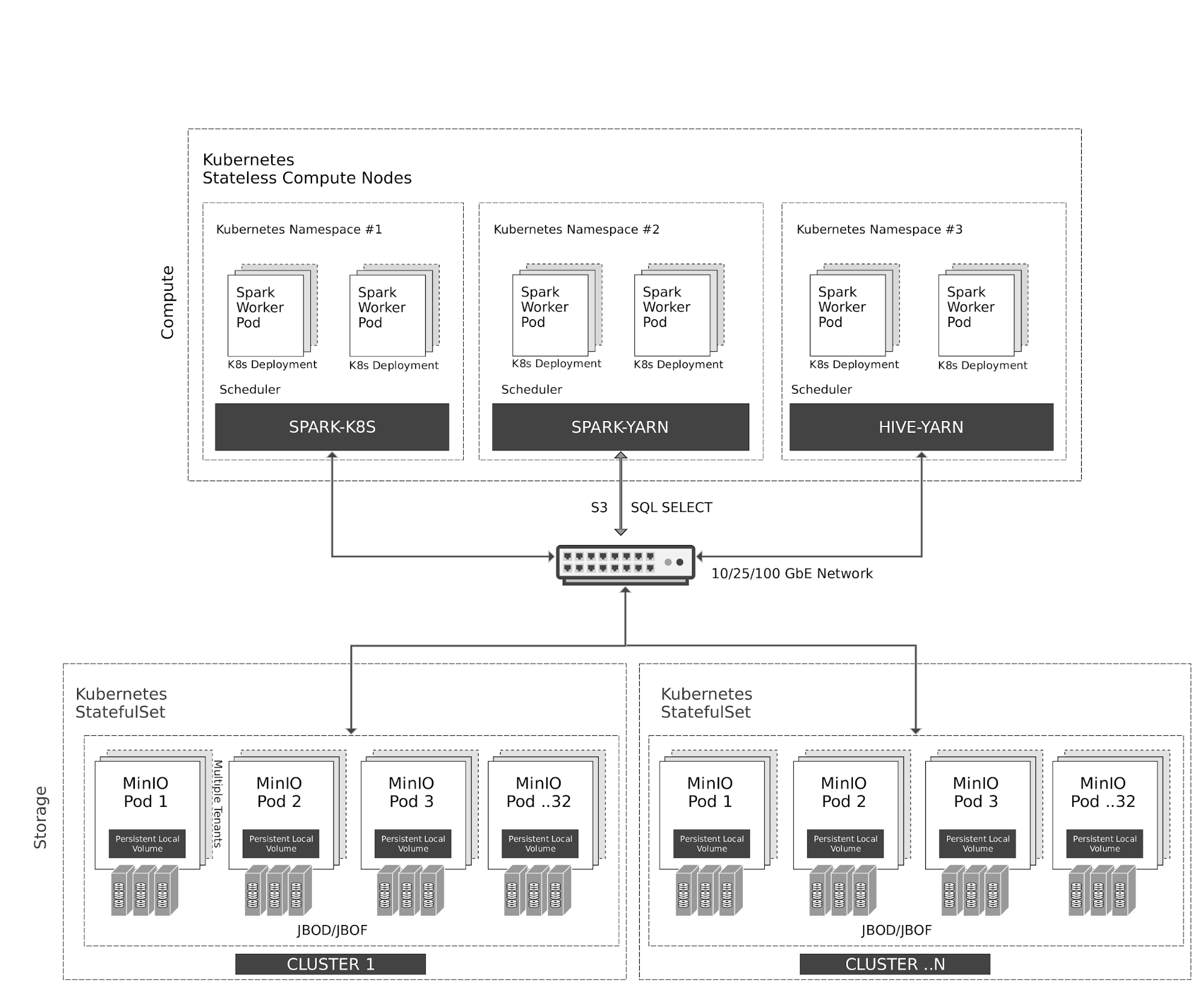
Kubernetes manages stateless Spark and Hive containers elastically on the compute nodes. Spark has native scheduler integration with Kubernetes. Hive, for legacy reasons, uses YARN scheduler on top of Kubernetes.
All access to MinIO object storage is via S3/SQL SELECT API. In addition to the compute nodes, MinIO containers are also managed by Kubernetes as stateful containers with local storage (JBOD/JBOF) mapped as persistent local volumes. This architecture enables multi-tenant MinIO, allowing isolation of data between customers.
MinIO also supports multi-cluster, multi-site federation similar to AWS regions and tiers. Using MinIO Information Lifecycle Management (ILM), you can configure data to be tiered between NVMe based hot storage, and HDD based warm storage. All data is encrypted with per-object key. Access Control and Identity Management between the tenants are managed by MinIO using OpenID Connect or Kerberos/LDAP/AD.
2. Prerequisites
- Install Hortonworks Distribution using this guide.
- Setup Ambari which automatically sets up YARN
- Installing Spark
- Install MinIO Distributed Server using one of the guides below.
3. Configure Hadoop, Spark, Hive to use MinIO
After successful installation navigate to the Ambari UI http://<ambari-server>:8080/ and login using the default credentials: [username: admin, password: admin]

3.1 Configure Hadoop
Navigate to Services -> HDFS -> CONFIGS -> ADVANCED as shown below
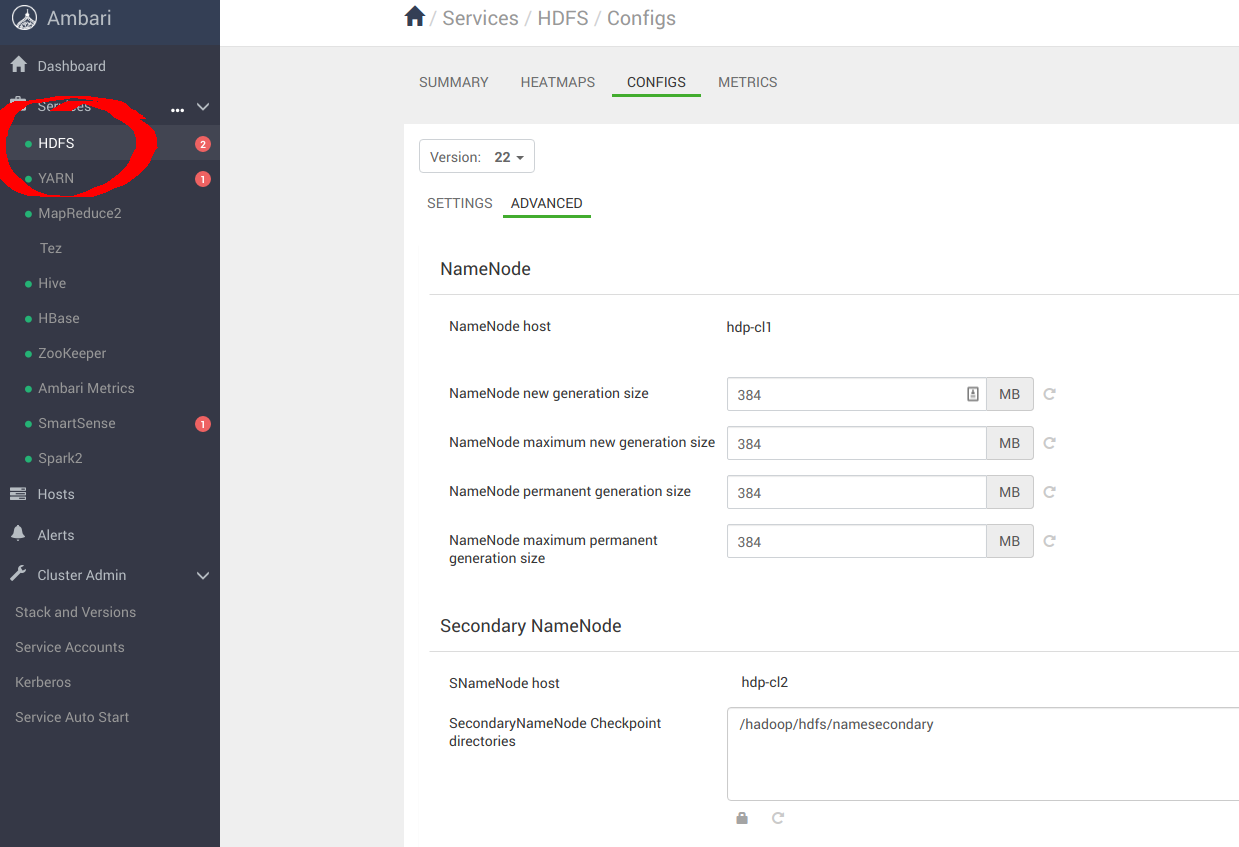
Navigate to Custom core-site to configure MinIO parameters for _s3a_ connector
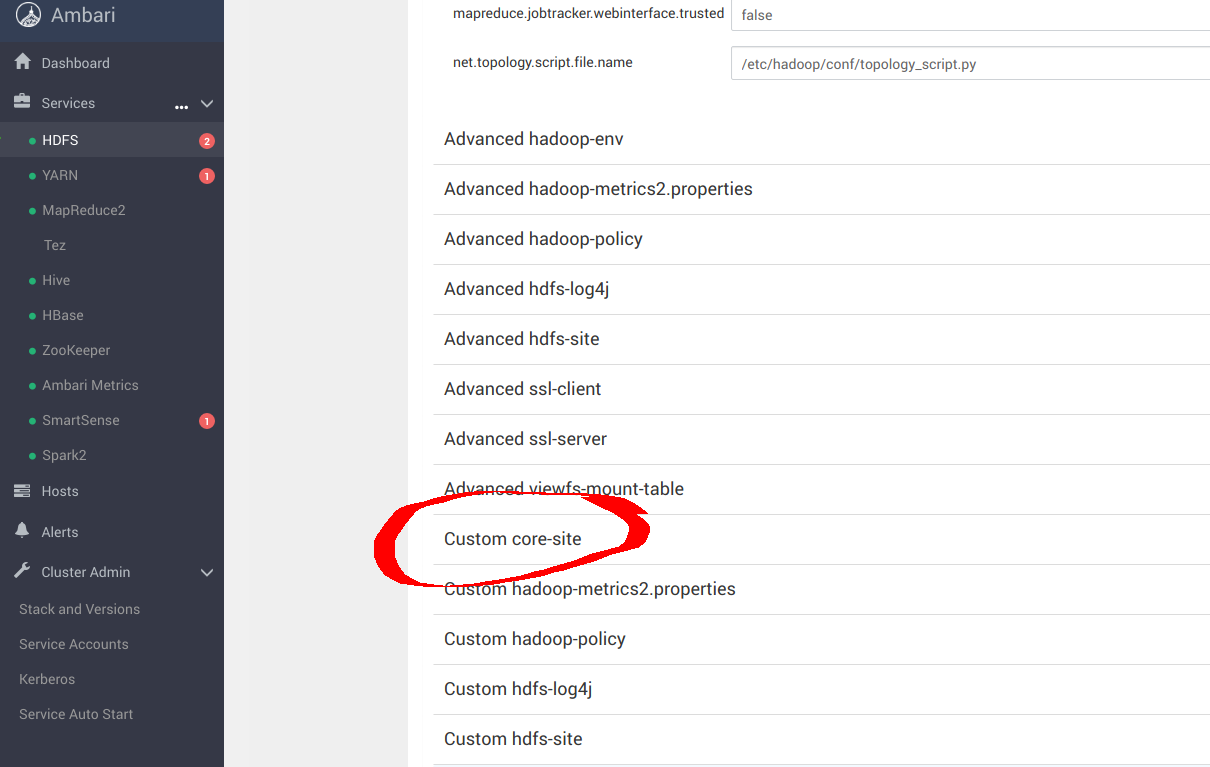
sudo pip install yq
alias kv-pairify='yq ".configuration[]" | jq ".[]" | jq -r ".name + \"=\" + .value"'
Let's take for example a set of 12 compute nodes with an aggregate memory of 1.2TiB, we need to do following settings for optimal results. Add the following optimal entries for core-site.xml to configure s3a with MinIO. Most important options here are
cat ${HADOOP_CONF_DIR}/core-site.xml | kv-pairify | grep "mapred"
mapred.maxthreads.generate.mapoutput=2 # Num threads to write map outputs
mapred.maxthreads.partition.closer=0 # Asynchronous map flushers
mapreduce.fileoutputcommitter.algorithm.version=2 # Use the latest committer version
mapreduce.job.reduce.slowstart.completedmaps=0.99 # 99% map, then reduce
mapreduce.reduce.shuffle.input.buffer.percent=0.9 # Min % buffer in RAM
mapreduce.reduce.shuffle.merge.percent=0.9 # Minimum % merges in RAM
mapreduce.reduce.speculative=false # Disable speculation for reducing
mapreduce.task.io.sort.factor=999 # Threshold before writing to disk
mapreduce.task.sort.spill.percent=0.9 # Minimum % before spilling to disk
S3A is the connector to use S3 and other S3-compatible object stores such as MinIO. MapReduce workloads typically interact with object stores in the same way they do with HDFS. These workloads rely on HDFS atomic rename functionality to complete writing data to the datastore. Object storage operations are atomic by nature and they do not require/implement rename API. The default S3A committer emulates renames through copy and delete APIs. This interaction pattern causes significant loss of performance because of the write amplification. Netflix, for example, developed two new staging committers - the Directory staging committer and the Partitioned staging committer - to take full advantage of native object storage operations. These committers do not require rename operation. The two staging committers were evaluated, along with another new addition called the Magic committer for benchmarking.
It was found that the directory staging committer was the fastest among the three, S3A connector should be configured with the following parameters for optimal results:
cat ${HADOOP_CONF_DIR}/core-site.xml | kv-pairify | grep "s3a"
fs.s3a.access.key=minio
fs.s3a.secret.key=minio123
fs.s3a.path.style.access=true
fs.s3a.block.size=512M
fs.s3a.buffer.dir=${hadoop.tmp.dir}/s3a
fs.s3a.committer.magic.enabled=false
fs.s3a.committer.name=directory
fs.s3a.committer.staging.abort.pending.uploads=true
fs.s3a.committer.staging.conflict-mode=append
fs.s3a.committer.staging.tmp.path=/tmp/staging
fs.s3a.committer.staging.unique-filenames=true
fs.s3a.connection.establish.timeout=5000
fs.s3a.connection.ssl.enabled=false
fs.s3a.connection.timeout=200000
fs.s3a.endpoint=http://minio:9000
fs.s3a.impl=org.apache.hadoop.fs.s3a.S3AFileSystem
fs.s3a.committer.threads=2048 # Number of threads writing to MinIO
fs.s3a.connection.maximum=8192 # Maximum number of concurrent conns
fs.s3a.fast.upload.active.blocks=2048 # Number of parallel uploads
fs.s3a.fast.upload.buffer=disk # Use disk as the buffer for uploads
fs.s3a.fast.upload=true # Turn on fast upload mode
fs.s3a.max.total.tasks=2048 # Maximum number of parallel tasks
fs.s3a.multipart.size=512M # Size of each multipart chunk
fs.s3a.multipart.threshold=512M # Size before using multipart uploads
fs.s3a.socket.recv.buffer=65536 # Read socket buffer hint
fs.s3a.socket.send.buffer=65536 # Write socket buffer hint
fs.s3a.threads.max=2048 # Maximum number of threads for S3A
The rest of the other optimization options are discussed in the links below
- https://hadoop.apache.org/docs/current/hadoop-aws/tools/hadoop-aws/index.html
- https://hadoop.apache.org/docs/r3.1.1/hadoop-aws/tools/hadoop-aws/committers.html
Once the config changes are applied, proceed to restart Hadoop services.
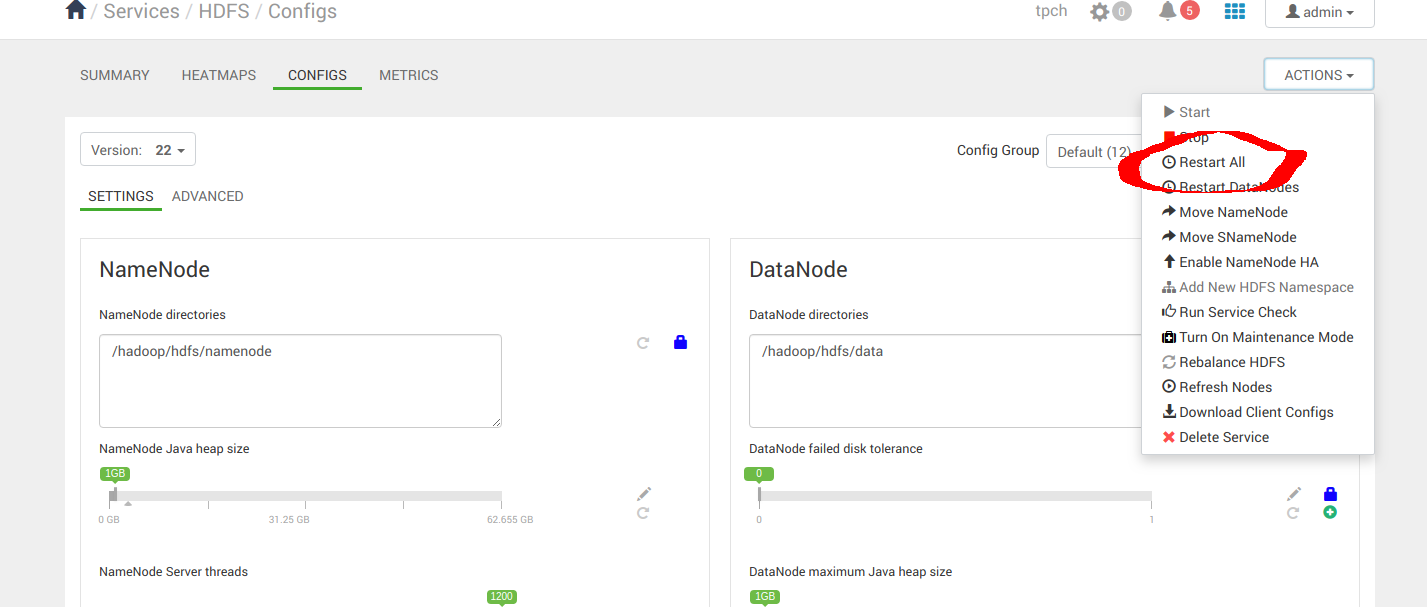
3.2 Configure Spark2
Navigate to Services -> Spark2 -> CONFIGS as shown below

Navigate to “Custom spark-defaults” to configure MinIO parameters for _s3a_ connector
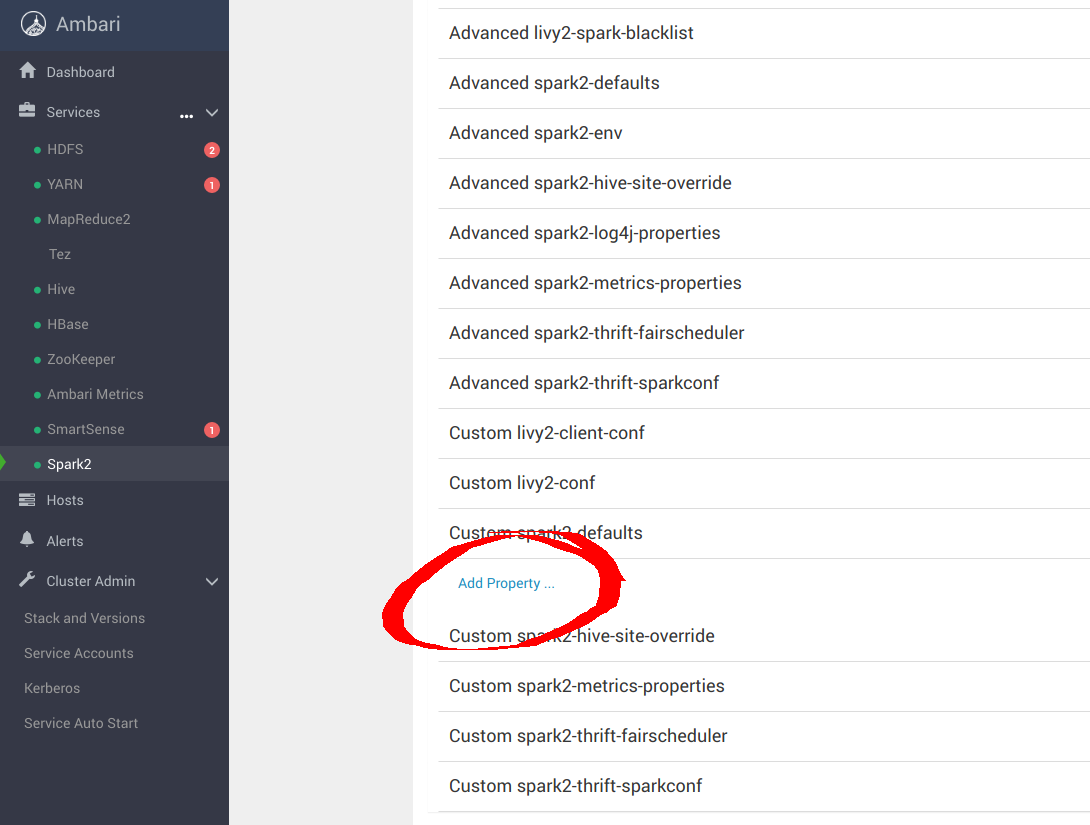
Add the following optimal entries for spark-defaults.conf to configure Spark with MinIO.
spark.hadoop.fs.s3a.access.key minio
spark.hadoop.fs.s3a.secret.key minio123
spark.hadoop.fs.s3a.path.style.access true
spark.hadoop.fs.s3a.block.size 512M
spark.hadoop.fs.s3a.buffer.dir ${hadoop.tmp.dir}/s3a
spark.hadoop.fs.s3a.committer.magic.enabled false
spark.hadoop.fs.s3a.committer.name directory
spark.hadoop.fs.s3a.committer.staging.abort.pending.uploads true
spark.hadoop.fs.s3a.committer.staging.conflict-mode append
spark.hadoop.fs.s3a.committer.staging.tmp.path /tmp/staging
spark.hadoop.fs.s3a.committer.staging.unique-filenames true
spark.hadoop.fs.s3a.committer.threads 2048 # number of threads writing to MinIO
spark.hadoop.fs.s3a.connection.establish.timeout 5000
spark.hadoop.fs.s3a.connection.maximum 8192 # maximum number of concurrent conns
spark.hadoop.fs.s3a.connection.ssl.enabled false
spark.hadoop.fs.s3a.connection.timeout 200000
spark.hadoop.fs.s3a.endpoint http://minio:9000
spark.hadoop.fs.s3a.fast.upload.active.blocks 2048 # number of parallel uploads
spark.hadoop.fs.s3a.fast.upload.buffer disk # use disk as the buffer for uploads
spark.hadoop.fs.s3a.fast.upload true # turn on fast upload mode
spark.hadoop.fs.s3a.impl org.apache.hadoop.spark.hadoop.fs.s3a.S3AFileSystem
spark.hadoop.fs.s3a.max.total.tasks 2048 # maximum number of parallel tasks
spark.hadoop.fs.s3a.multipart.size 512M # size of each multipart chunk
spark.hadoop.fs.s3a.multipart.threshold 512M # size before using multipart uploads
spark.hadoop.fs.s3a.socket.recv.buffer 65536 # read socket buffer hint
spark.hadoop.fs.s3a.socket.send.buffer 65536 # write socket buffer hint
spark.hadoop.fs.s3a.threads.max 2048 # maximum number of threads for S3A
Once the config changes are applied, proceed to restart Spark services.

3.3 Configure Hive
Navigate to Services -> Hive -> CONFIGS-> ADVANCED as shown below

Navigate to “Custom hive-site” to configure MinIO parameters for _s3a_ connector

Add the following optimal entries for hive-site.xml to configure Hive with MinIO.
hive.blobstore.use.blobstore.as.scratchdir=true
hive.exec.input.listing.max.threads=50
hive.load.dynamic.partitions.thread=25
hive.metastore.fshandler.threads=50
hive.mv.files.threads=40
mapreduce.input.fileinputformat.list-status.num-threads=50
For more information about these options please visit https://www.cloudera.com/documentation/enterprise/5-11-x/topics/admin_hive_on_s3_tuning.html
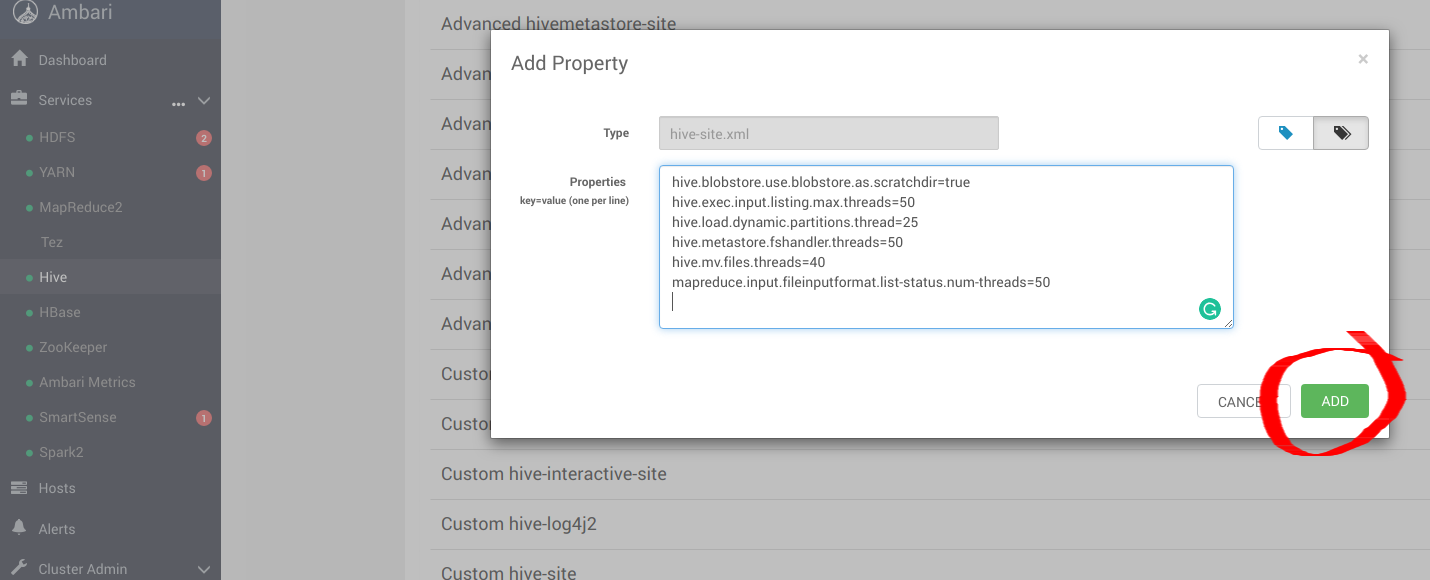
Once the config changes are applied, proceed to restart all Hive services.
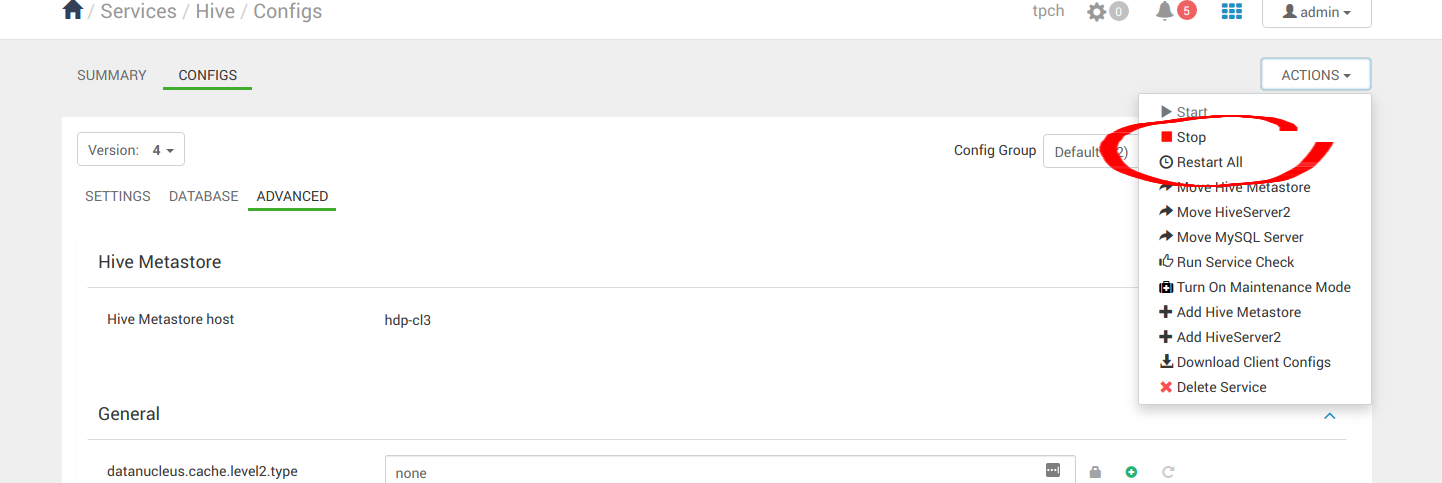
4. Run Sample Applications
After installing Hive, Hadoop and Spark successfully, we can now proceed to run some sample applications to see if they are configured appropriately. We can use Spark Pi and Spark WordCount programs to validate our Spark installation. We can also explore how to run Spark jobs from the command line and Spark shell.
4.1 Spark Pi
Test the Spark installation by running the following compute intensive example, which calculates pi by “throwing darts” at a circle. The program generates points in the unit square ((0,0) to (1,1)) and counts how many points fall within the unit circle within the square. The result approximates pi.
Follow these steps to run the Spark Pi example:
- Login as user ‘spark’.
- When the job runs, the library can now use MinIO during intermediate processing.
- Navigate to a node with the Spark client and access the spark2-client directory:
cd /usr/hdp/current/spark2-client
su spark
- Run the Apache Spark Pi job in yarn-client mode, using code from org.apache.spark:
./bin/spark-submit --class org.apache.spark.examples.SparkPi \
--master yarn-client \
--num-executors 1 \
--driver-memory 512m \
--executor-memory 512m \
--executor-cores 1 \
examples/jars/spark-examples*.jar 10
The job should produce an output as shown below. Note the value of pi in the output.
17/03/22 23:21:10 INFO DAGScheduler: Job 0 finished: reduce at SparkPi.scala:38, took 1.302805 s
Pi is roughly 3.1445191445191445
Job status can also be viewed in a browser by navigating to the YARN ResourceManager Web UI and clicking on job history server information.
4.2 WordCount
WordCount is a simple program that counts how often a word occurs in a text file. The code builds a dataset of (String, Int) pairs called counts, and saves the dataset to a file.
The following example submits WordCount code to the Scala shell. Select an input file for the Spark WordCount example. We can use any text file as input.
- Login as user ‘spark’.
- When the job runs, the library can now use MinIO during intermediate processing.
- Navigate to a node with Spark client and access the spark2-client directory:
cd /usr/hdp/current/spark2-client
su spark
The following example uses log4j.properties as the input file:
4.2.1 Upload the input file to HDFS:
hadoop fs -copyFromLocal /etc/hadoop/conf/log4j.properties
s3a://testbucket/testdata
4.2.2 Run the Spark shell:
./bin/spark-shell --master yarn-client --driver-memory 512m --executor-memory 512m
The command should produce an output as shown below. (with additional status messages):
Spark context Web UI available at http://172.26.236.247:4041
Spark context available as 'sc' (master = yarn, app id = application_1490217230866_0002).
Spark session available as 'spark'.
Welcome to
____ __
/ __/__ ___ _____/ /__
_\ \/ _ \/ _ `/ __/ '_/
/___/ .__/\_,_/_/ /_/\_\ version 2.1.0.2.6.0.0-598
/_/
Using Scala version 2.11.8 (Java HotSpot(TM) 64-Bit Server VM, Java 1.8.0_112)
Type in expressions to have them evaluated.
Type :help for more information.
scala>
- At the scala> prompt, submit the job by typing the following commands, Replace node names, file name, and file location with your values:
scala> val file = sc.textFile("s3a://testbucket/testdata")
file: org.apache.spark.rdd.RDD[String] = s3a://testbucket/testdata MapPartitionsRDD[1] at textFile at <console>:24
scala> val counts = file.flatMap(line => line.split(" ")).map(word => (word, 1)).reduceByKey(_ + _)
counts: org.apache.spark.rdd.RDD[(String, Int)] = ShuffledRDD[4] at reduceByKey at <console>:25
scala> counts.saveAsTextFile("s3a://testbucket/wordcount")
Use one of the following approaches to view job output:
View output in the Scala shell:
scala> counts.count()
364
To view the output from MinIO exit the Scala shell. View WordCount job status:
hadoop fs -ls s3a://testbucket/wordcount
The output should be similar to the following:
Found 3 items
-rw-rw-rw- 1 spark spark 0 2019-05-04 01:36 s3a://testbucket/wordcount/_SUCCESS
-rw-rw-rw- 1 spark spark 4956 2019-05-04 01:36 s3a://testbucket/wordcount/part-00000
-rw-rw-rw- 1 spark spark 5616 2019-05-04 01:36 s3a://testbucket/wordcount/part-00001
